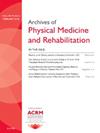手持式操作评估(IHMA)的心理计量学验证。
IF 3.6
2区 医学
Q1 REHABILITATION
Archives of physical medicine and rehabilitation
Pub Date : 2025-06-01
DOI:10.1016/j.apmr.2024.11.009
引用次数: 0
摘要
目的:探讨脑卒中后手操作能力评估量表(IHMA)的信度、标准效度和判别效度。设计:对参与者进行录像,完成IHMA,并由两名盲法评估者评分,以确定评估者之间的信度。卒中参与者还完成了Jebsen-Taylor手功能测试,健康参与者完成了九孔栓测试以确定IHMA的效度。环境:社区和医院环境。参与者:46名参与者,22名健康的年轻人,14名健康的老年人和10名中风患者。干预:不适用。结果:IHMA的等级间信度良好(所有参与者:等级内相关系数 = )。78 ~ 0.98, p≤0.001;中风参与者:Kappa统计 = 。70 ~ 1.00 (p≤0.001)。健康青年和健康老年人的时间和完成度得分具有良好的判别效度(ps = )。012和≤.001)。与九孔栓测验相比,IHMA的标准效度为中等至良好(r = - 0.45 - 0.84),但与捷成-泰勒手功能测验无显著相关。根据参与者的表现对IHMA任务和指令进行修改,以提高其在中风后患者中的临床应用。结论:本量表具有良好的量表间信度、判别效度和中效度。修订《医疗卫生管理条例》的建议将加强其管理。本文章由计算机程序翻译,如有差异,请以英文原文为准。
Psychometric Validation of the In-Hand Manipulation Assessment
Objective
To determine the inter-rater reliability, and criterion and discriminant validity of the In-Hand Manipulation Assessment (IHMA) with patients after stroke.
Design
Participants were videotaped, completing the IHMA and scored by 2 blinded assessors to determine the inter-rater reliability. Stroke participants also completed the Jebsen-Taylor Hand Function Test, and healthy participants completed the Nine-Hole Peg Test to determine the validity of the IHMA.
Setting
Community and hospital settings.
Participants
A total of 46 participants with 22 healthy young adults, 14 healthy older adults and 10 people with stroke.
Interventions
Not applicable.
Main Outcome Measures
Not applicable.
Results
The inter-rater reliability of the IHMA was good (for all participants: intraclass correlation coefficient = 0.78-0.98, P≤.001; for stroke participants: Kappa statistics = 0.70-1.00, P≤.001). The IHMA demonstrated good discriminant validity between the healthy young adults and healthy older adults for time and completion scores (Ps=.012 and ≤.001). The criterion validity of the IHMA was moderate to good when compared with the Nine-Hole Peg Test (r = −0.45 to 0.84), but no significant correlation was found with the Jebsen-Taylor Hand Function Test. Modifications to the IHMA tasks and instructions were made based on the performance of participants to improve its clinical utility with people after stroke.
Conclusions
The IHMA demonstrated good inter-rater reliability, good discriminant validity, and moderate-to-good criterion validity with the Nine-Hole Peg Test. The proposed modifications to the IHMA will enhance its administration.
求助全文
通过发布文献求助,成功后即可免费获取论文全文。
去求助
来源期刊
CiteScore
6.20
自引率
4.70%
发文量
495
审稿时长
38 days
期刊介绍:
The Archives of Physical Medicine and Rehabilitation publishes original, peer-reviewed research and clinical reports on important trends and developments in physical medicine and rehabilitation and related fields. This international journal brings researchers and clinicians authoritative information on the therapeutic utilization of physical, behavioral and pharmaceutical agents in providing comprehensive care for individuals with chronic illness and disabilities.
Archives began publication in 1920, publishes monthly, and is the official journal of the American Congress of Rehabilitation Medicine. Its papers are cited more often than any other rehabilitation journal.

 求助内容:
求助内容: 应助结果提醒方式:
应助结果提醒方式:


